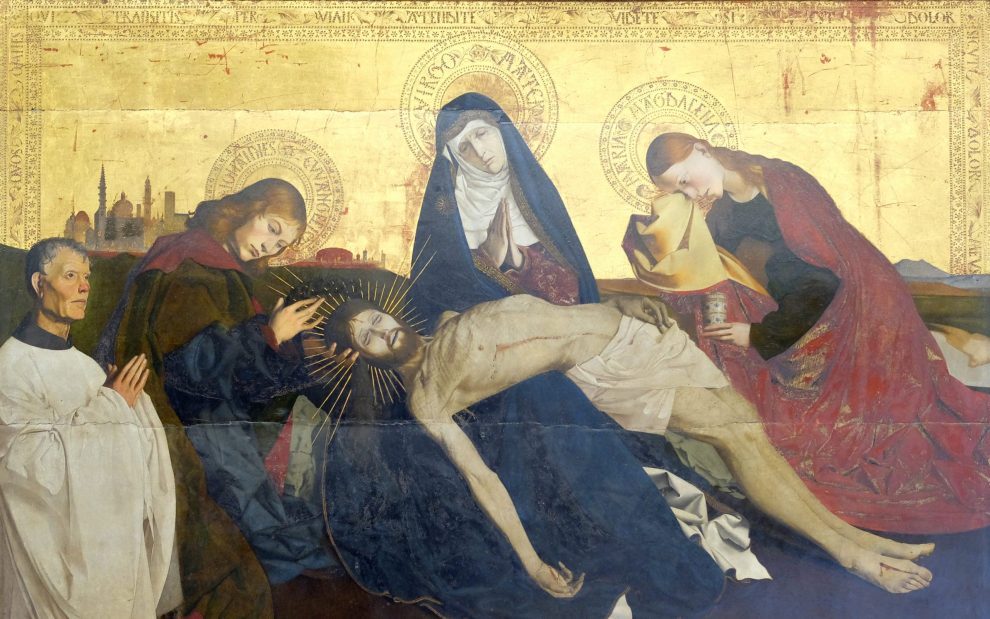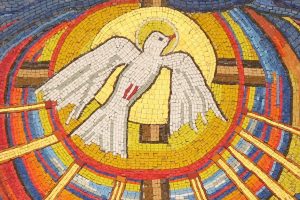When my Uncle Joe died a few years ago, his Pentecostal sisters from northeastern Tennessee insisted that the casket remain open during the service, despite the disapproval of my aunt’s more staid Quaker minister, who seemed concerned to avoid anything overly emotional.
The sisters won out, though, and as the time came to say their final goodbyes, they shocked some in the central Indiana congregation a bit: As they took their leave, each sister bent down to kiss the face of her dead brother. Even the Catholic members of my family seemed a little surprised, though I guess we shouldn’t have been.
After all, our Catholic funeral rites encourage us not only to touch our dead loved ones but to touch them in a special way by making the sign of the cross on their foreheads, marking them once more with the sign of salvation. It was the same sign they first received before their baptism, when in the name of the. Church the presider claimed them for Christ and invited their parents, godparents, and others gathered to do the same.
It was also a sign that marked so many comings and goings in their lives as Christians—Sunday Mass, nighttime prayers, mealtime blessings—a sign traced with oil and water and ashes. And so it marks their final passing as well, our act of faith on their behalf, a sign of our confidence that Christ’s cross has indeed saved them from death despite the evidence to the contrary.
To be honest, I’m not any more comfortable touching dead people than the rest of my family. The first time I did it, I was repulsed by the rubbery texture of embalmed skin, the macabre illusion of life painted on the face of my friend Peter.
But as I traced the cross I remembered other times I had touched this friend—the handshake at our meeting, an embrace at the sign of peace, a final goodbye the last time I saw him. Though I knew his body was but a shell now, that Peter was “gone,” his body was still his sacrament, his “visible sign,’ the only way I had ever known him.
Peter’s body had been the bearer of his ridiculous cackle, his mischievous grin, his funny walk, and his less funny yet endless practical jokes. By signing him with the same cross that I mark myself with, I knew us still to be one in its saving mystery, bridged by the wood that unites heaven and earth.
It sometimes seems that modern funeral customs do everything they can to keep us away from death. The deceased are ensconced in steel caskets lined with plush upholstery, then entombed in concrete vaults, as if to prevent decay. We wake the dead in dimly lit, carpeted rooms that are sometimes ridiculously called “salons.” We drain bodies of every biological fluid, color death away with paint, and then refuse to touch them.
But our tradition always calls us back, to touch, to remember, to show faith, and ultimately to recognize that we, too, must make that journey, that our bodies, too, will rely on others to make the saving sign when death has robbed them of movement. Perhaps that’s why we shy away.
I have to say, though, that marking the dead with the cross has made me less afraid of death myself. Don’t get me wrong, I’m not checking the paper every day for a new wake to attend, and I’m in no rush to have others send me on my final journey.
Yet marking the dead with the cross is a sign of hope, a proclamation that sickness and death no longer have the final word. In resurrection’s light, death is but part of the human journey, a path shaded at every twist and turn by the tree of life.
I was with my grandma at the hospital when she died last spring. Her body seemed peaceful, even relieved, in death, though diminished by life’s departure and months of struggle for a full breath. This time I did not think twice. As I prepared to leave her for the last time, I traced the sign of the cross on her forehead, still warm with life’s echoes.
Her final cross has passed, and mine is yet to come, but its mark bridges that gap that separates us, and its power will one day reunite my grandma and me, along with all who are marked with the sign of faith.
Image: Wikimedia Commons














Add comment